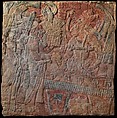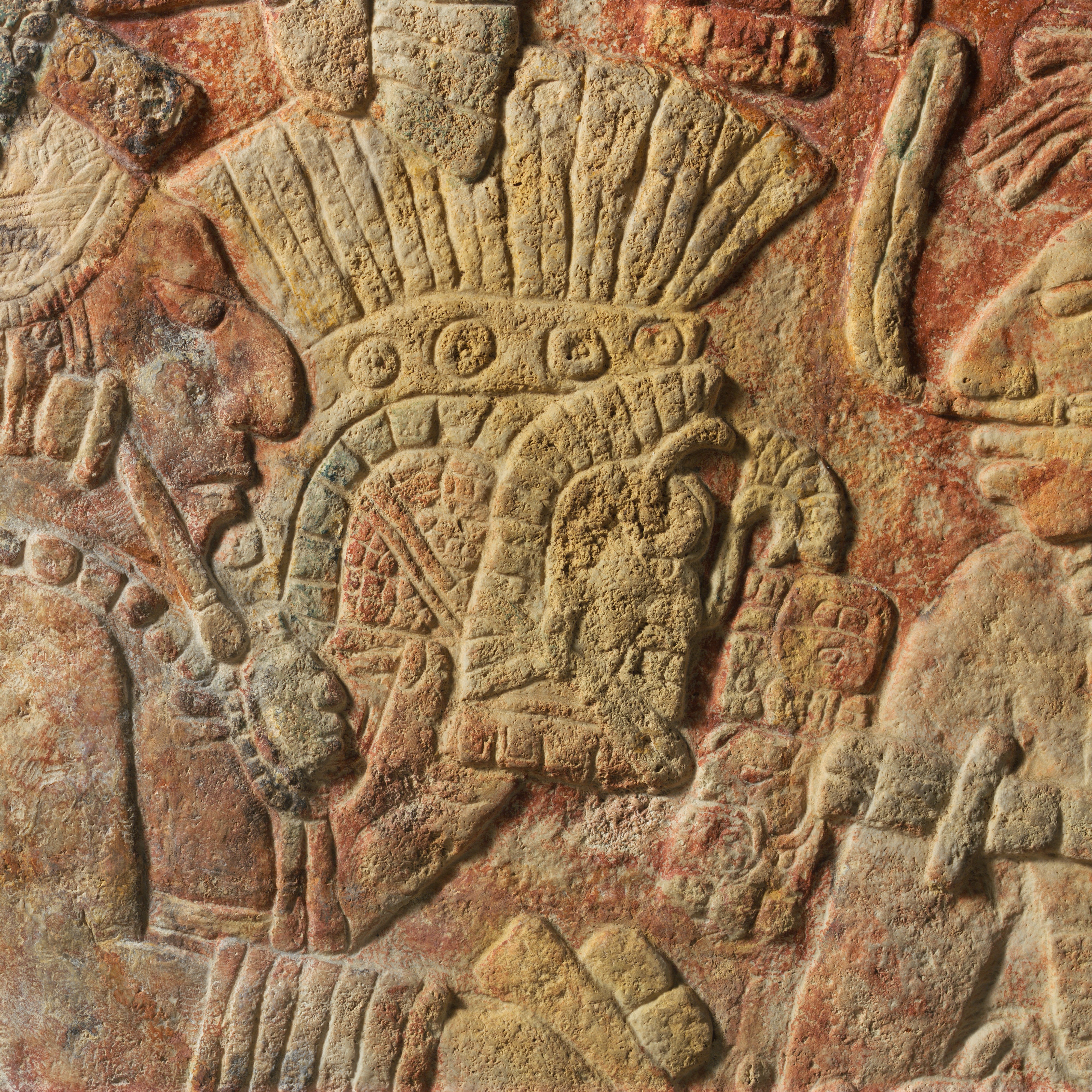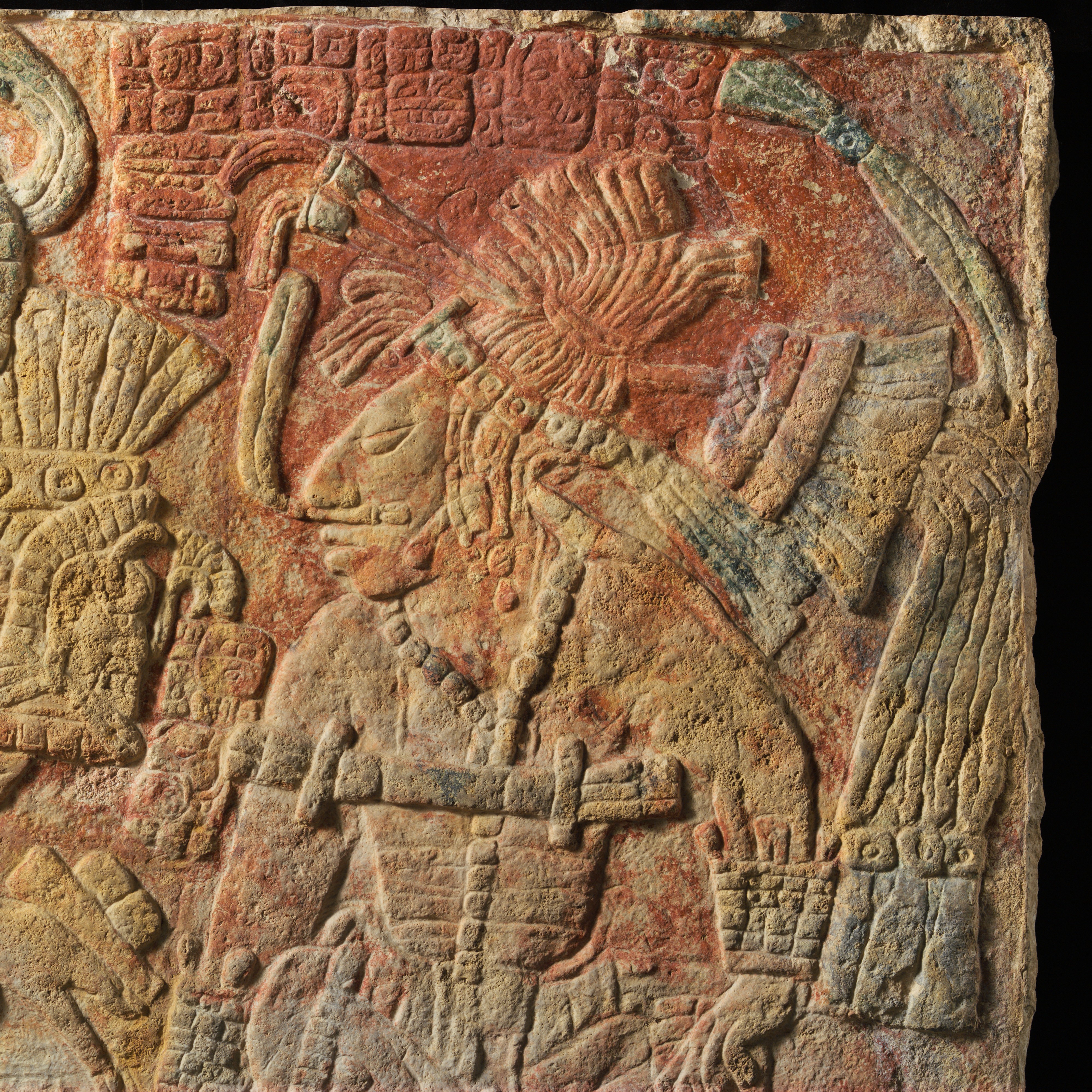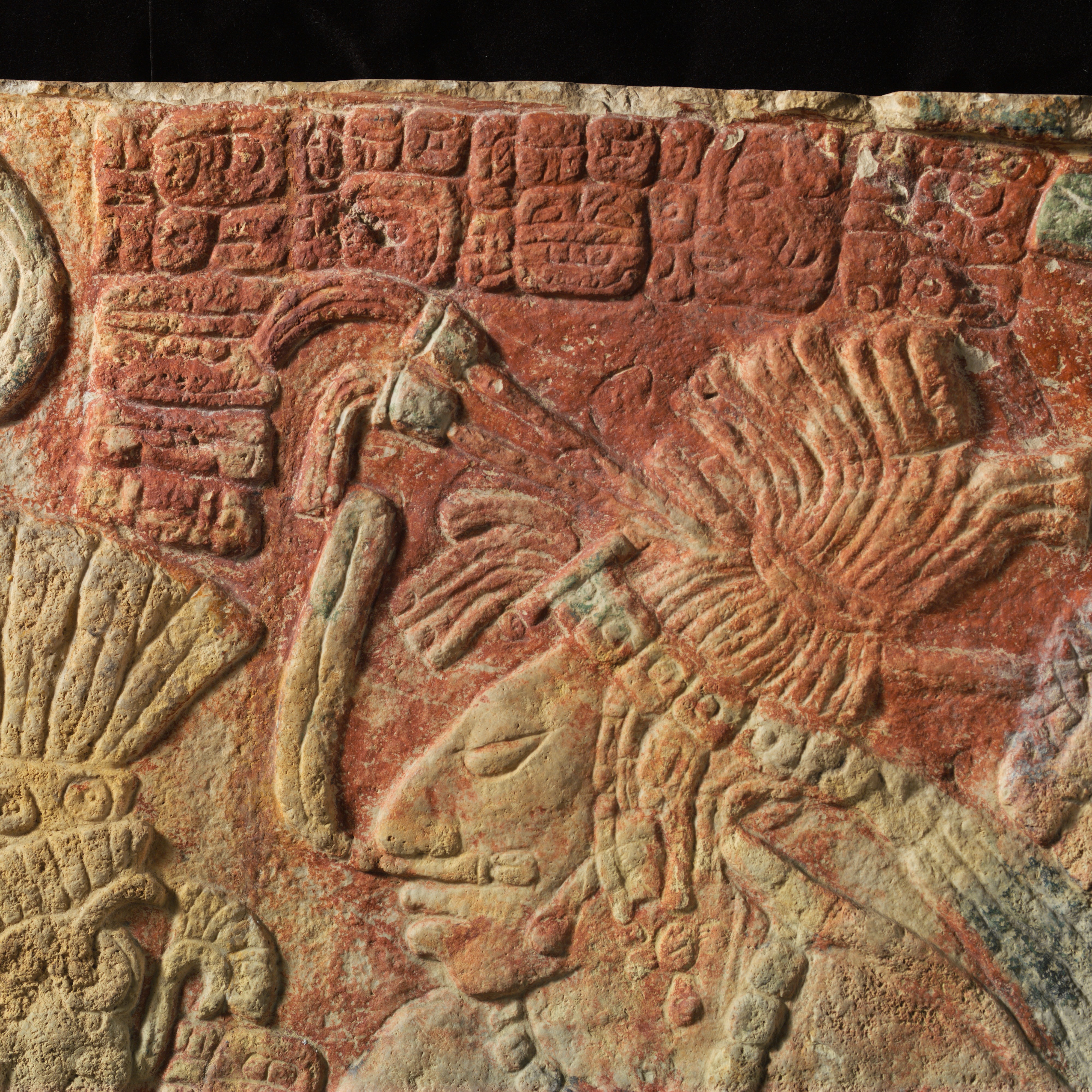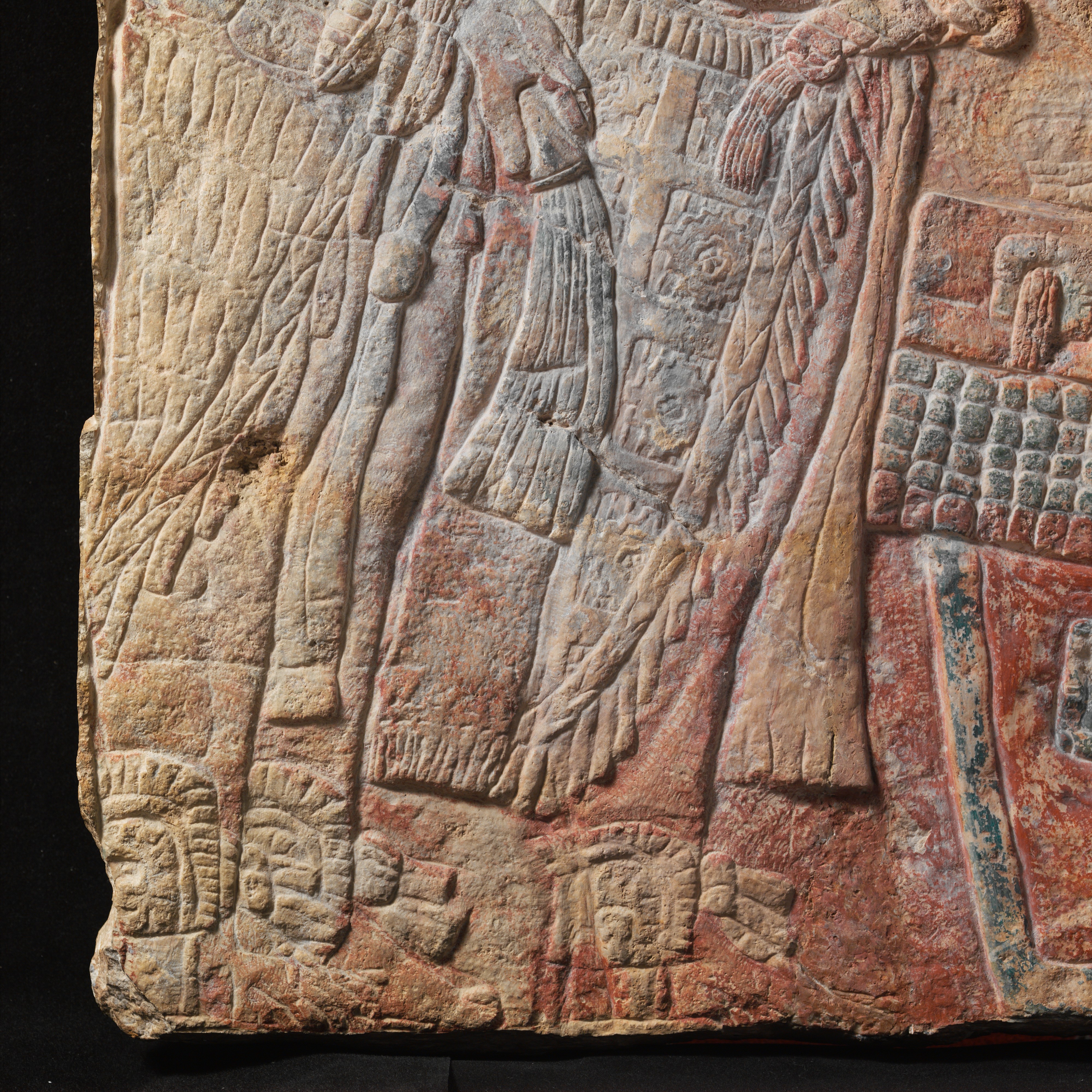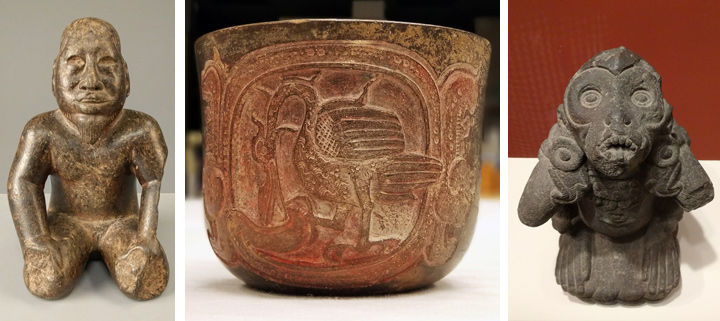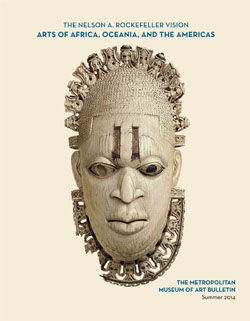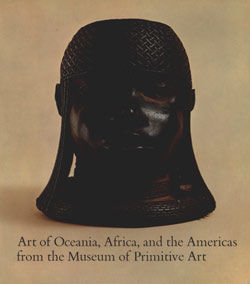Relief with Enthroned Ruler
Chakalte' Guatemalan or Mexican
Not on view
This Maya landmark was likely the carved lintel of a doorway from the site of La Pasadita in northwestern Guatemala carved in the early A.D. 770s. The relief panel would have been installed parallel to the floor of the entrance of a temple at La Pasadita. Visitors to the building were thus forced to look upward to view the monument, and perhaps even had to light the surface with raking torchlight in order to read the image and the text. The Metropolitan lintel is striking for the amount of pigment preserved on the surface. A variety of red, yellow-orange, and blue-green pigment remains to give clues about the original brightly colored appearance of the lintels. The jade jewels of the main characters and the details on the ruler’s throne glisten in blue-green, a color that symbolized the ‘first/newest’ and most precious materials.
In the 8th century, the small hilltop site La Pasadita was caught between the power struggles of the self-proclaimed divine kings of the river kingdoms of Yaxchilan (modern-day Chiapas, Mexico), and Piedras Negras (Guatemala). During the Classic Maya period (ca. A.D. 250-900), the two major royal courts vied for power, paid tribute to one another, intermarried, and engaged in conflict with subsidiary local lords. Loyalties sometimes shifted, boundaries between the two city-states were often fortified, and artistic programs sponsored by the lords and ladies served as propaganda to stake claims on the contested landscape.
The Yaxchilan kings and queens favored elaborate sculpted doorway lintels at the royal capital, and they made sure their local allies marked their palaces in the same way. At least a dozen related lintel reliefs are known from subsidiary sites around Yaxchilan. Likely commissioned by the Yaxchilan rulers themselves, most show the ruler from Yaxchilan in the company of the local lord in a supporting role in some ritual, making an overt statement of political sovereignty.
The Met’s lintel depicts three protagonists: the figure seated on the right is faced by two standing ones to the left. The main figure offering an elaborate headdress to the seated leader is the La Pasadita ruler named Tiloom (ti-lo-ma), who ruled from approximately A.D. 750s-770s, using the title of sajal, a title for subsidiary regional governors. Tiloom is represented on at least three other known doorway sculptures: one in the Ethnologisches Museum in Berlin (IV Ca 45530), one in the collection of the Museum of Ethnology in Leiden (3939-1), and one in an unknown private collection. The Berlin lintel dates to A.D. 759, and the Leiden monument dates to A.D. 766; the private collection lintel dates to A.D. 771. Based on the known sculptures of Tiloom, the Metropolitan lintel is contemporaneous with the private collection lintel, probably carved between 769 and the early 780s.
Tiloom was a loyal provincial ruler to the final two major kings of Yaxchilan, the father and son rulers of Bird Jaguar IV and Shield Jaguar IV. Bird Jaguar IV ruled from A.D. 752-768, and Shield Jaguar IV from 769 to around the turn of the 9th century. Bird Jaguar IV dominates the Berlin and Leiden lintels, in which Tiloom assists in a captive presentation and a scattering of incense, respectively. The ‘Sun Lord’ captive depicted in the Berlin Lintel is likely from Piedras Negras, and is the final portrayal of the many war victories of Bird Jaguar IV, who referred to himself as ‘he of 20 captives.’ In the Leiden panel, commemorating an event that occurred seven years after the Berlin captive presentation scene, Tiloom assists Bird Jaguar IV with a ‘scattering’ ritual in which the king drops blood or incense into a basket. The lintel from 771 in which Tiloom dances in a bird costume alone perhaps signals a shift in authority from one overlord to the other; Tiloom celebrated his own right to rule rather than his supporting role to the Yaxchilan king.
The Metropolitan Lintel also dates from the early 770s; in fact, the same sculptor carved the two lintels, an individual by the name of Chakalte’. Sculptors’ signatures are relatively rare in Maya art, though many are known from the area around Yaxchilan and Piedras Negras. Chakalte’ was probably a sculptor who worked under the patronage of Shield Jaguar IV. That leader was known to send out sculptors to the other provincial lords, such as the rulers of the well-known site of Bonampak. Sculptors were sometimes important members of the royal courts; at Piedras Negras it seems that a master sculptor oversaw an atelier of apprentices who all signed the same works. Many hands thus crafted these royal portraits.
Chakalte’ composed the Met’s lintel scene so that the visitor would be first greeted by the enthroned ruler, Shield Jaguar IV, facing the interior of the structure. The king leans forward towards his visitors, wearing an elaborate feathered hair ornament, a feathered nose plug, and a beaded jade necklace with bar pendant. Tiloom then stands proudly presenting the Yaxchilan holy lord with a headdress and what could be packets of incense or a plate of tamales. Tiloom wears a jaded headband and human head pectoral, with an elaborate woven skirt with a geometric pattern. A third personage stands behind Tiloom in a similar outfit but with a type of sombrero associated in other scenes with travelers or merchants. The text names the Yaxchilan "divine" lord with his pre-accession name of Chel Te’ Chan K’inich, which he changed to Shield Jaguar early in his reign because it was a namesake of ancestral rulers of the kingdom. The text naming Tiloom as the sajal, provincial lord, is squeezed in next to the ruler’s arm and the offertory headdress, almost as if Chakalte’ had not originally planned to include it. A bowl of sliced fruit with seeds visible sits under the throne, presumably part of the offering brought to the seated ruler.
La Pasadita was visited in the 1970s by renowned explorer and monument recorder Ian Graham, but subsequently became dangerous for scholarly visits because of border conflicts during the decades-long civil conflict in Guatemala. Land mines and security problems prevented archaeological work until 1998, when Charles Golden and colleagues performed reconnaissance in the area. Even today the site lies within a troubled zone suffering the effects of narcotrafficking and illegal settlements within the national parks in the Usumacinta River drainage.
The Metropolitan lintel provides key information for the understanding of Classic Maya politics on the eve of institutional collapse at the end of the 8th century. It shows the final major Yaxchilan lord receiving tribute in the form of food and regalia from a lord loyal to his warlord father, known as "he of 20 captives." But by the beginning of the 9th century, the dynasty at Yaxchilan ceased to build temples or commission monuments, silencing the voices of La Pasadita lord Tiloom and his sculptor of choice, Chakalte’.
James Doyle, 2015
Resources and Additional Reading
Bussel, G. W., and T. J. J. Leyenaar. 1991. Maya of Mexico. Leiden, The National Museum of Ethnology.
Freidel, David, and Linda Schele 1990. Forest of Kings: The Untold Story of the Ancient Maya. New York, William Morrow.
Golden, Charles, Andrew K. Scherer, A. René Muñoz, and Rosaura Vásquez. 2008. Piedras Negras and Yaxchilan: Divergent Political Trajectories in Adjacent Maya Polities. Latin American Antiquity 19(3): 249-274.
Golden, Charles, and Andrew K. Scherer. 2013. Territory, Trust, Growth, and Collapse in Classic Period Maya Kingdoms. Current Anthropology 54(4): 397-435.
"Border problems: recent archaeological research along the Usumacinta River." PARI Journal 7(2):1–16.
Golden, Charles W. 2010. Frayed at the edges: the re-creation of histories and memories on the frontiers of Classic period Maya polities. Ancient Mesoamerica 21(2): 373–384.
"The politics of warfare in the Usumacinta Basin: La Pasadita and the realm of Bird Jaguar." In Ancient Mesoamerican Warfare. M. Kathryn Brown and Travis W. Stanton, eds. pp. 31–48. Walnut Creek, CA: AltaMira.
Grube, Nikolai, and Marie Gaida. 2006 Die Maya: Schrift und Kunst. Berline, SMB-Dumont.
Houston, Stephen. 2013. Carving Credit: Authorship among Classic Maya Sculptors. Paper presented at Making Value, Making Meaning: Techné in the Pre-columbian World, a Symposium at Dumbarton Oaks.
Martin, Simon, and Nikolai Grube. Chronicle of the Maya Kings and Queens. New York, Thames & Hudson, 2000.
Mathews, Peter. Tilom, in Who’s Who in the Classic Maya World, Foundation for the Advancement of Mesoamerican Studies, Inc., 2005, http://research.famsi.org/whos_who/people.php?mathewsnumber=PSD%20001
Schele, Linda, and Mary Ellen Miller. The Blood of Kings: Dynasty and Ritual in Maya Art. Fort Worth, Kimbell Art Museum, 1986.
Simpson, Jon Erik. The New York Relief Panel and Some Associations with Reliefs at Palenque and Elsewhere, Part 1, in Segunda Mesa Redonda de Palenque, edited by Merle Greene Robertson, Pebble Beach, Pre-Columbian Art Research Institute, 1976, pp. 95-105.
Due to rights restrictions, this image cannot be enlarged, viewed at full screen, or downloaded.
This artwork is meant to be viewed from right to left. Scroll left to view more.
